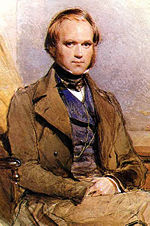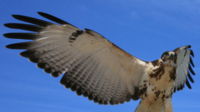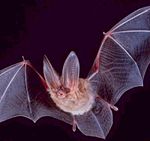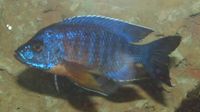Introduction to evolution
2008/9 Schools Wikipedia Selection. Related subjects: Evolution and reproduction
|
Genetic changes between generations either increase or decrease the chance of an organism's survival. |
| Overview |
| Life forms reproduce to make offspring. |
| The offspring differs from the parent in minor random ways. |
| If the differences are helpful, the offspring is more likely to survive and reproduce. |
| This means that more offspring in the next generation will have the helpful difference. |
| These differences accumulate resulting in changes within the population. |
| Over time, this process gradually leads to entirely new types of life. |
| This process is responsible for the many diverse life forms in the world today. |
|
The evolutionary history of species has been described as a " tree", with many branches arising from a single trunk. While Haeckel's tree is somewhat outdated, it illustrates clearly the principles that more complex modern reconstructions can obscure. |
Evolution is the changes that happen in all forms of life over generations, and evolutionary biology is the study of how and why evolution occurs. An organism inherits features (called traits) from its parents through genes. Changes (called mutations) in these genes can produce a new trait in the offspring of an organism. If a new trait makes these offspring better suited to their environment, they will be more successful at surviving and reproducing. This process is called natural selection, and it causes useful traits to become more common. Over many generations, a population can acquire so many new traits that it becomes a new species.
The understanding of evolutionary biology began with the 1859 publication of Charles Darwin's On the Origin of Species. In addition, Gregor Mendel's work with plants helped to explain the hereditary patterns of genetics. This led to an understanding of the mechanisms of inheritance. Further discoveries on how genes mutate, as well as advances in population genetics explained more details of how evolution occurs. Scientists now have a good understanding of the origin of new species ( speciation). They have observed the speciation process happening both in the laboratory and in the wild. This modern view of evolution is the principal theory that scientists use to understand life.
Darwin's idea: evolution by natural selection
Charles Darwin developed the idea that each species had developed from ancestors with similar features, and in 1838, he described how a process he called natural selection would make this happen. Darwin's idea of how evolution works relied on the following observations:
- 1. If all the individuals of a species reproduced successfully, the population of that species would increase uncontrollably.
- 2. Populations tend to remain about the same size from year to year.
- 3. Environmental resources are limited.
- 4. No two individuals in a given species are exactly alike.
- 5. Much of this variation in a population can be passed on to offspring.
- 2. Populations tend to remain about the same size from year to year.
Darwin deduced that since organisms produce more offspring than the world could possibly support, there must be a competitive struggle for survival - only a few individuals can survive out of each generation. Darwin realized that it was not chance alone that determined survival. Instead, survival depends on the traits of each individual and if these traits aid or hinder survival and reproduction. Well-adapted, or "fit", individuals are likely to leave more offspring than their less well-adapted competitors. Darwin realized that the unequal ability of individuals to survive and reproduce could cause gradual changes in the population. Traits that help an organism survive and reproduce would accumulate over generations. On the other hand, traits that hinder survival and reproduction would disappear. Darwin used the term natural selection to describe this process.
Observations of variations in animals and plants formed the basis of the theory of natural selection. For example, Darwin observed that orchids and insects have a close relationship that allows the pollination of the plants. He noted that orchids have a variety structures that attract insects - so that pollen from the flowers gets stuck to the insects’ bodies. In this way, insects transport the pollen from a male to a female orchid. In spite of the elaborate appearance of orchids, these specialized parts are made from the same basic structures that make up other flowers. Darwin proposed that the orchid flowers did not represent the work of an ideal engineer, but were adapted from pre-existing parts, through natural selection.
Darwin was still researching and experimenting with his ideas on natural selection when he received a letter from Alfred Wallace describing a theory almost the same as his own. This led to an immediate joint publication of both theories. Both Wallace and Darwin saw the history of life like a family tree, with each fork in the tree’s limbs being a common ancestor. The tips of the limbs represented modern species and the branches represented the common ancestors that are shared amongst many different species. To explain these relationships, Darwin said that all living things were related, and this meant that all life must be descended from a few forms, or even from a single common ancestor. He called this process, "descent with modification".
Darwin published his theory of evolution by natural selection in On the Origin of Species in 1859. His theory means that all life, including humanity, is a product of continuing natural processes. The implication that all life on earth has a common ancestor has met with objections from some religious groups who believe even today that the different types of life are due to special creation. Their objections are in contrast to the level of support for the theory by more than 99 percent of those within the scientific community today.
Modern synthesis
The modern evolutionary synthesis was the outcome of a merger of several different scientific fields into a cohesive understanding of evolutionary theory. In the 1930s and 1940s, efforts were made to merge Darwin's theory of natural selection, research in heredity, and understandings of the fossil records into a unified explanatory model. The application of the principles of genetics to naturally occurring populations, by scientists such as Theodosius Dobzhansky and Ernst Mayr, advanced understanding of the processes of evolution. Dobzhansky's 1937 work Genetics and the Origin of Species was an important step in bridging the gap between genetics and field biology. Mayr, on the basis of an understanding of genes and direct observations of evolutionary processes from field research, introduced the biological species concept, which defined a species as a group of interbreeding or potentially interbreeding populations that are reproductively isolated from all other populations. The paleontologist George Gaylord Simpson helped to incorporate fossil research, which showed a pattern consistent with the branching and non-directional pathway of evolution of organisms predicted by the modern synthesis.
The modern synthesis emphasizes the importance of populations as the unit of evolution, the central role of natural selection as the most important mechanism of evolution, and the idea of gradualism to explain how large changes evolve as an accumulation of small changes over long periods of time.
Evidence for evolution
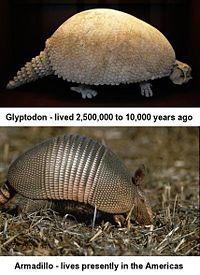
Scientific evidence for evolution comes from many aspects of biology, and includes fossils, homologous structures, and molecular similarities between species' DNA.
Fossil record
Research in the field of paleontology, the study of fossils, supports the idea that all living organisms are related. Fossils provide evidence that accumulated changes in organisms over long periods of time have led to the diverse forms of life we see today. A fossil itself reveals the organism's structure and the relationships between present and extinct species, allowing paleontologists to construct a family tree for all of the life forms on earth.
Modern paleontology began with the work of Georges Cuvier (1769–1832). Cuvier noted that, in sedimentary rock, each layer contained a specific group of fossils. The deeper layers, which he proposed to be older, contained simpler life forms. He noted that many forms of life from the past are no longer present today. One of Cuvier’s successful contributions to the understanding of the fossil record was establishing extinction as a fact. In an attempt to explain extinction, Cuvier proposed the idea of “revolutions” or catastrophism in which he speculated that geological catastrophes had occurred throughout the earth’s history, wiping out large numbers of species. Cuvier's theory of revolutions was later replaced by uniformitarian theories, notably those of James Hutton and Charles Lyell who proposed that the earth’s geological changes were gradual and consistent. However, current evidence in the fossil record supports the concept of mass extinctions. As a result, the general idea of catastrophism has re-emerged as a valid hypothesis for at least some of the rapid changes in life forms that appear in the fossil records.
A very large number of fossils have now been discovered and identified. These fossils serve as a chronological record of evolution. The fossil record provides examples of transitional species that demonstrate ancestral links between past and present life forms. One such transitional fossil is Archaeopteryx, an ancient organism that had the distinct characteristics of a reptile, yet had the feathers of a bird. The implication from such a find is that modern reptiles and birds arose from a common ancestor.
Comparative anatomy
The comparison of similarities between organisms of their form or appearance of parts, called their morphology, has long been a way to classify life into closely related groups. This can be done by comparing the structure of adult organisms in different species or by comparing the patterns of how cells grow, divide and even migrate during an organism's development.
- Taxonomy
Taxonomy is the branch of biology that names and classifies all living things. Scientists use morphological and genetic similarities to assist them in categorizing life forms based on ancestral relationships. For example, orangutans, gorillas, chimpanzees, and humans all belong to the same taxonomic grouping referred to as a family – in this case the family called Hominidae. These animals are grouped together because of similarities in morphology that come from common ancestry (called homology). Strong evidence for evolution comes from the analysis of homologous structures in different species that no longer perform the same task. Such is the case of the forelimbs of mammals. The forelimbs of a human, cat, whale, and bat all have strikingly similar bone structures. However, each of these four species' forelimbs performs a different task. The same bones that construct a bird's wings, which are used for flight, also construct a whale's flippers, which are used for swimming. Such a "design" makes little sense if they are unrelated and uniquely constructed for their particular tasks. The theory of evolution explains these homologous structures: all four animals shared a common ancestor, and each has undergone change over many generations. These changes in structure have produced forelimbs adapted for different tasks.
- Embryology
In some cases, anatomical comparison of structures in the embryos of two or more species provides evidence for a shared ancestor that may not be obvious in the adult forms. As the embryo develops, these homologies can be lost to view, and the structures can take on different functions. Part of the basis of classifying the vertebrate group (which includes humans), is the presence of a tail (extending beyond the anus) and pharyngeal gill slits. Both structures appear during some stage of embryonic development but are not always obvious in the adult form.
Because of the morphological similarities present in embryos of different species during development, it was once assumed that organisms re-enact their evolutionary history as an embryo. It was thought that human embryos passed through an amphibian then a reptilian stage before completing their development as mammals. Such a re-enactment, called ontogeny recapitulates phylogeny, is not supported by scientific evidence. What does occur, however, is that the first stages of development are similar in broad groups of organisms. At the pharyngula stage, for instance, all vertebrates are extremely similar, but do not exactly resemble any ancestral species. As development continues, the features specific to the species emerge from the basic pattern.
- Vestigial structures
Homology includes a unique group of shared structures referred to as vestigial structures. Vestigial refers to anatomical parts that are of minimal, if any, value to the organism that possesses them. These apparently illogical structures are remnants of organs that played an important role in ancestral forms. Such is the case in whales, which have small vestigial bones that appear to be remnants of the leg bones of their ancestors which walked on land. Humans also have vestigial structures, including the ear muscles, the wisdom teeth, the appendix, the tail bone, body hair (including goose bumps), and the semilunar fold in the corner of the eye.
- Convergent evolution
Anatomical comparisons can be misleading, as not all anatomical similarities indicate a close relationship. Organisms that share similar environments will often develop similar physical features, a process known as convergent evolution. Both sharks and dolphins have similar body forms, yet are only distantly related – sharks are fish and dolphins are mammals. Such similarities are a result of both populations being exposed to the same selective pressures. Within both groups, changes that aid swimming have been favored. Thus, over time, they developed similar appearances (morphology), even though they are not closely related.
Molecular biology
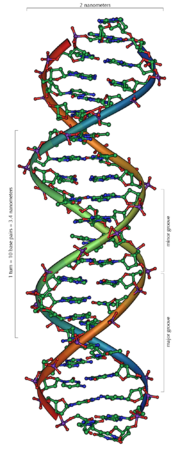
Every living organism contains molecules of DNA, which carries genetic information. Genes are the pieces of DNA that carry this information, and they influence the properties of an organism. Genes determine an individual's general appearance and to some extent their behaviour. If two organisms are closely related, their DNA will be very similar. On the other hand, the more distantly related two organisms are, the more differences they will have. For example, two brothers will be very closely related and will have very similar DNA, while distant cousins will have far more differences in their DNA. Similarities in DNA are used to determine the relationships between species in much the same manner as they are used to show relationships between individuals. For example, comparing chimpanzees with gorillas and humans shows that there is as much as a 96 percent similarity between the DNA of humans and chimps, and that humans and chimpanzees are more closely related to each other than either species is to gorillas.
The field of molecular systematics focuses on measuring the similarities in these molecules and using this information to work out how different types of organisms are related through evolution. These comparisons have allowed biologists to build a relationship tree of the evolution of life on earth. They have even allowed scientists to unravel the relationships between organisms whose common ancestors lived such a long time ago that no real similarities remain in the appearance of the organisms.
Co-evolution
Co-evolution is a process in which two or more species influence the evolution of each other. All organisms are influenced by life around them; however, in co-evolution there is evidence that genetically determined traits in each species directly resulted from the interaction between the two organisms.
An extensively documented case of co-evolution is the relationship between Pseudomyrmex, a type of ant, and the acacia, a plant that the ant uses for food and shelter. The relationship between the two is so intimate that it has led to the evolution of special structures and behaviors in both organisms. The ant defends the acacia against herbivores and clears the forest floor of the seeds from competing plants. In response, the plant has evolved swollen thorns that the ants use as shelter and special flower parts that the ants eat. Such co-evolution does not imply that the ants and the tree choose to behave in an altruistic manner. Rather, across a population small genetic changes in both ant and tree benefited each. The benefit gave a slightly higher chance of the characteristic being passed on to the next generation. Over time, successive mutations created the relationship we observe today.
Species
Given the right circumstances, and enough time, evolution leads to the emergence of new species. Scientists have struggled to find a precise and all-inclusive definition of species. Ernst Mayr (1904–2005) defined a species as a population or group of populations whose members have the potential to interbreed naturally with one another to produce viable, fertile offspring. (The members of a species cannot produce viable, fertile offspring with members of other species). Mayr's definition has gained wide acceptance among biologists, but does not apply to organisms such as bacteria, which reproduce asexually.
Speciation is the lineage-splitting event that results in two separate species forming from a single common ancestral population. A widely accepted method of speciation is called allopatric speciation. Allopatric speciation begins when a population becomes geographically separated. Geological processes, such as the emergence of mountain ranges, the formation of canyons, or the flooding of land bridges by changes in sea level may result in separate populations. For speciation to occur, separation must be substantial, so that genetic exchange between the two populations is completely disrupted. In their separate environments, the genetically isolated groups follow their own unique evolutionary pathways. Each group will accumulate different mutations as well as be subjected to different selective pressures. The accumulated genetic changes may result in separated populations that can no longer interbreed if they are reunited. Barriers that prevent interbreeding are either prezygotic (prevent mating or fertilization) or postzygotic (barriers that occur after fertilization). If interbreeding is no longer possible, then they will be considered different species.
Usually the process of speciation is slow, occurring over very long time spans; thus direct observations within human life-spans are rare. However speciation has been observed in present day organisms, and past speciation events are recorded in fossils. Scientists have documented the formation of five new species of cichlid fishes from a single common ancestor that was isolated fewer than 5000 years ago from the parent stock in Lake Nagubago. The evidence for speciation in this case was morphology (physical appearance) and lack of natural interbreeding. These fish have complex mating rituals and a variety of colorations; the slight modifications introduced in the new species have changed the mate selection process and the five forms that arose could not be convinced to interbreed.
Different views on the mechanism of evolution
 |
|
| James Hutton | |
 |
|
| Stephen Jay Gould | |
 |
|
| Richard Dawkins |
The theory of evolution is widely accepted among the scientific community, serving to link the diverse specialty areas of biology. Evolution provides the field of biology with a solid scientific base. The significance of evolutionary theory is best described by the title of a paper by Theodosius Dobzhansky (1900–1975), published in American Biology Teacher; " Nothing in Biology Makes Sense Except in the Light of Evolution". Nevertheless, the theory of evolution is not static. There is much discussion within the scientific community concerning the mechanisms behind the evolutionary process. For example, the rate at which evolution occurs is still under discussion. In addition, there are conflicting opinions as to which is the primary unit of evolutionary change—the organism or the gene.
Rate of change
Two views exist concerning the rate of evolutionary change. Darwin and his contemporaries viewed evolution as a slow and gradual process. Evolutionary trees are based on the idea that profound differences in species are the result of many small changes that accumulate over long periods.
The view that evolution is gradual had its basis in the works of the geologist James Hutton (1726–1797) and his theory called " gradualism". Hutton's theory suggests that profound geological change was the cumulative product of a relatively slow continuing operation of processes which can still be seen in operation today, as opposed to catastrophism which promoted the idea that sudden changes had causes which can no longer be seen at work. A uniformitarian perspective was adopted for biological changes. Such a view can seem to contradict the fossil record, which shows evidence of new species appearing suddenly, then persisting in that form for long periods. The paleontologist Stephen Jay Gould (1940–2002) developed a model that suggests that evolution, although a slow process in human terms, undergoes periods of relatively rapid change over only a few thousand or million years, alternating with long periods of relative stability, a model called "punctuated equilibrium" which explains the fossil record without contradicting Darwin's ideas.
Unit of change
It is generally accepted amongst biologists that the unit of selection in evolution is the organism, and that natural selection serves to either enhance or reduce the reproductive potential of an individual. Reproductive success, therefore, can be measured by the volume of an organism's surviving offspring. The organism view has been challenged by a variety of biologists as well as philosophers. Richard Dawkins (born 1941) proposes that much insight can be gained if we look at evolution from the gene's point of view; that is, that natural selection operates as an evolutionary mechanism on genes as well as organisms. In his book The Selfish Gene, he explains:
| “ | Individuals are not stable things, they are fleeting. Chromosomes too are shuffled to oblivion, like hands of cards soon after they are dealt. But the cards themselves survive the shuffling. The cards are the genes. The genes are not destroyed by crossing-over; they merely change partners and march on. Of course they march on. That is their business. They are the replicators and we are their survival machines. When we have served our purpose we are cast aside. But genes are denizens of geological time: genes are forever. | ” |
Others view selection working on many levels, not just at a single level of organism or gene; for example, Stephen Jay Gould called for a hierarchical perspective on selection.
Artificial selection
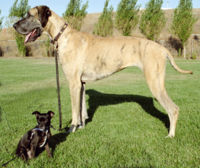
Artificial selection is the controlled breeding of domestic plants and animals. The farmer determines which animal or plant will reproduce and which of the offspring will survive. The farmer 'chooses' which genes will be passed on to future generations. The process of artificial selection has had a significant impact on the evolution of domestic animals. For example, people have produced different types of dogs by controlled breeding. The differences in size between the Chihuahua and the Great Dane are the result of artificial selection. Despite their dramatically different physical appearance, they and all other dogs evolved from a few wolves domesticated by humans in what is now China less than 15,000 years ago.
Artificial selection has produced a wide variety of plants. In the case of maize (corn), recent genetic evidence suggests that domestication occurred 10,000 years ago in central Mexico. Prior to domestication, the edible portion of the wild form was small and difficult to collect. Today The Maize Genetics Cooperation • Stock Centre maintains a collection of more than 10,000 genetic variations of maize that have arisen by random mutations and chromosomal variations from the original wild type.
In artificial selection the new breed or variety is the one with random mutations attractive to humans, while in natural selection the surviving species is the one with random mutations useful to it in its environment. In both natural and artificial selection the variations are a result of random mutations, and the underlying genetic processes are essentially the same. Darwin carefully observed the outcomes of artificial selection in animals and plants to form many of his arguments in support of natural selection. Much of his book On the Origin of Species was based on these observations of the many varieties of domestic pigeons arising from artificial selection. Darwin proposed that if humans could achieve dramatic changes in domestic animals in short periods, then natural selection, given millions of years, could produce the differences seen in living things today.
Summary
| Evolution in popular culture |
| The language of evolution became pervasive in Victorian Britain as Darwin's work spread and became better known: |
| " Survival of the fittest" – used by Herbert Spencer in Principles of Biology (1864) |
| " Nature, red in tooth and claw" – from Alfred Lord Tennyson's In Memoriam A.H.H. (1849) While this poem preceded the publication of Darwin's work in 1859, it came to represent evolution for both evolution detractors and supporters. |
| It even merited a song in Gilbert and Sullivan's 1884 opera, Princess Ida, which concludes: "Darwinian man, though well behaved, |
Several basic observations establish the theory of evolution, which explains the variety and relationship of all living things. There are genetic variations within a population of individuals. Some individuals, by chance, have features that allow them to survive and thrive better than their kind. The individuals that survive will be more likely to have offspring of their own. The offspring might inherit the useful feature.
Evolution is not a random process for creating new life forms. While mutations are random, natural selection is not. Evolution is an inevitable result of imperfectly copying, self-replicating organisms reproducing over billions of years under the selective pressure of the environment. The result is not perfectly designed organisms. Rather, the result is individuals that can survive better than their nearest neighbour can in a particular environment. Fossils, the genetic code, and the peculiar distribution of life on earth, which demonstrates the common ancestry of all organisms, both living and long dead, provide a record of evolution. Evolution can be directly observed in artificial selection, the selective breeding for certain traits of domestic animals and plants. The diverse breeds of cats, dogs, horses, and agricultural plants serve as examples of evolution.
Although some groups raise objections to the theory of evolution, the evidence of observation and experiments over a hundred years by thousands of scientists supports evolution. The result of four billion years of evolution is the diversity of life around us, with an estimated 1.75 million different species in existence today.

